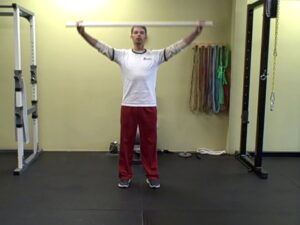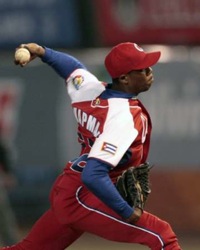Mobilizing the Throwing Shoulder: The Do and Don’t
Q: I recently opened up my own place to train athletes, and wanted to thank you for all of the knowledge you have passed along, as it has been a big factor in designing my own training philosophy. The majority of my athletes are baseball and football players in the high school and collegiate level, and I had question for you regarding my baseball players specifically.
Nearly every player I work with (and for the most part every pitcher I have worked with), has tight shoulders due to over-use, being imbalanced, and weak. I have them performing a ton of upper back work in comparison to pressing movements, rotator cuff work, sleeper stretches, and myofascial release. It helps greatly, but they still seem to never get back to a full range of motion or an actual natural throwing motion. Because of this, I was wondering what you thought about adding in shoulder dislocations using a dowel rod or broomstick to help with shoulder mobility.
Because the players I work with are either in college because of their ability to play baseball, or have a chance at being drafted or getting a good college scholarship from their arms, I want to make sure that everything I do makes them better instead of hurting them in the long run for what looks like a quick fix when they are with me.
I’d love to hear any thoughts you might have on helping increase shoulder mobility and the shoulder dislocation exercise, in particular.


A: First off, thank you very much for your kind words and continued support.
Unfortunately, to be blunt, I think it would be a terrible idea and you would undoubtedly make a lot of shoulders (and potentially elbows) worse.
Most pitchers will have increased external rotation (ER) on their dominant side, and as such, increased anterior instability. If you just crank them into external rotation and/or horizontal abduction, you will exacerbate that anterior instability. Think about what happens in the apprehension-relocation test at the shoulder; the relocation posteriorly pushes the humerus to relieve symptoms by taking away anterior instability.
We are extremely careful with who we select for exercises to increase external rotation, and it is in the small minority. Most pitchers gain ~5 degrees of external rotation over the course of the competitive season, as it is. If we are going to have them do mobilizations to increase ER, it’s only after we’ve measured their total motion (IR+ER) as asymmetrical and determined that they need ER (a sign is ER that is less on the dominant shoulder). And, any exercises we provide on this front are done in conjunction with concurrent scapular stabilization and thoracic spine extension/rotation – as you’d see in a side-lying extension-rotation drill.
Here, you’ve got supination of the forearm, external rotation of the shoulder, scapular retraction/posterior tilt, and thoracic spine extension/rotation occurring simultaneously on the “lay back” component. And, the opposite occurs as the athlete returns to the starting position. Again, to reiterate, this is NOT a drill that is appropriate for a large chunk of throwing shoulders who already have crazy external rotation; it’s just one we use with specific cases of guys we discover need to gain it.
With the broomstick dislocation, you’re going to be throwing a lot of valgus stress on the elbow – and as I noted in my recent six-part series on elbow pain, pitchers already get enough of that. To read a bit more, check out Part 3: Throwing Injuries.
While we’re on the topic, be careful about universally recommending sleeper stretches. There is going to be a decent chunk of your baseball players that don’t need it at all. In particular, if you have a congenitally lax (ultra hypermobile) athlete (high score on Beighton laxity test), a sleeper stretch will really irritate the anterior shoulder capsule and/or biceps tendon.
These players don’t really need to be stretched into IR; they just need loads of stability training. You’ll find that these guys become more and more common at higher levels, as congenital laxity serves as a sort of “natural selection” to succeed for some people. So, universally prescribing the sleeper stretch becomes more and more of a problem as you deal with more and more advanced players and could be jacking up multi-million dollar arms. You’ll even find guys who can gain 10-20 degrees of internal rotation in a matter of 30 seconds – without any shoulder mobilizations – just with the appropriate breathing patterns. It just doesn’t work for everyone. Honestly, the only way to know is to assess; each pitcher is unique.
The obvious question then becomes “why are you seeing shoulder “tightness.?” Is it postural? Is it an actual range of motion you’ve assessed? Is it guarding/apprehension in certain positions? And, what is a “natural throwing motion?” They said Mark Prior had “perfect mechanics” and he has been injured his entire career.

What is “natural” is not what is “effective” in many cases, so you have to appreciate that throwing is an unnatural motion that may be necessary for generating velocity, creating deception, and optimizing movement on a certain pitch.
It might seem like shameless self-promotion, but I would highly recommend that you pick up the DVD set Mike Reinold and I recently released: Optimal Shoulder Performance.
It covers all of this information in great detail, plus a ton more. Baseball players – and particularly pitchers – are a unique population as a whole, and within that population, each one is unique.
I’d also strongly encourage you to check out Mike Reinold’s webinar, “Assessing Asymmetry in Overhead Athletes: Does Asymmetry Mean Pathology?” It’s available through the Advanced CEU online store.
Sign-up Today for our FREE Baseball Newsletter and Receive a Copy of the Exact Stretches
used by Cressey Performance Pitchers after they Throw!




